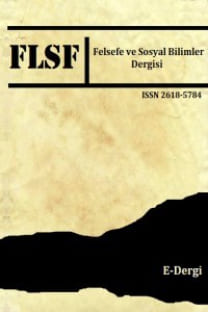ŞİDDETİN İZİNİ SÜRMEK: ŞİDDET NEDİR?
Bu makalenin amacı, “şiddet nedir?” sorusundan yola çıkarak şiddet kavramının bir çözümlemesini yapmaktır. Bu çözümleme salt ne analitik ne fenomenolojik ne de diyalektik olup bunların hepsini belli bir dereceye kadar içeren bir çözümlemedir. Çalışmanın ilk kısmında çeşitli şiddet tanımları üzerinde durulmuştur. Daha sonra bu tanımlardan bazılarının izi sürülerek olumsuzlama olarak şiddet ele alınmış ve etraflıca incelenmiştir. Sonuç olarak da şiddet kavramına yönelik bazı saptamalarda bulunulmuştur. Örneğin, biri ve diğeri arasındaki olumsuzlama ilişkisinin sonucunda, şiddetin ön olgusu adı verilebilecek bir durum ortaya çıkar. Buna göre, biri kendini olumlamak isterken kaçınılmaz olarak diğerini olumsuzlamak zorundadır. Olumsuzlama kavramı, kuvvet ve ihlal kavramı ele alındığında onları bazı bakımlardan içeren bir kavramdır. Bununla birlikte bu, olumsuzlamanın olduğu her yerde fiziksel kuvvetin olacağı anlamına gelmemelidir. Gerçi kuvvet uygulayımında da olumsuzlamada da yıkıcılık vardır ama olumsuzlamanın yıkıcılığı kimlik olarak konumun bütününe yöneliktir
Anahtar Kelimeler:
Şiddet, kuvvet, ihlal, olumsuzlama, Hegel
To Scent Out the Violence: What is Violence?
The aim of this article is to analyze and define the concept of violence in the context of the question of “what is violence?”. This analysis is neither only analytic nor phenomenological nor dialectical but includes all of them to some extent. In the first part of the article, several definitions of violence has been exposed and examined. After that, by tracing some of the definitions the concept of violence is tried to be defined from the perspective of negation. And subsequently some important points of the concept have been stated. For example, a fact that can be called the prima facie of the violence emerges from the result of the relationship between the one and the other. According to this, one inevitably has to negate the other while it wants to affirm itself. The concept of the negation, in some respects, contains the concepts of the force and the violation. However, it does not mean that a physical force must always accompany to negation. Though there is the destruction in both of them, the destruction of the negation is for the totality of position as identity
___
- ARENDT, Hannah. Şiddet Üzerine (Çev. Bülent Peker), İstanbul: İletişim yay., 2009.
- BACK, Allan. “Thinking Clearly About Violence”, Philosophical Studies, 117: 219-230, 2004.
- BENJAMİN, Walter (2010) “Şiddetin Eleştirisi Üzerine”, Şiddetin Eleştirisi Üzerine (Ed. Aykut Çelebi), İstanbul: Metis, 2010. ss. 19-42.
- BETZ, Joseph. “Violence: Garver’s Definition and a Deweyan Correction”, Ethics, Vol 87. No:4, 1977. ss. 339-351.
- BUFACCHİ, Vittorio. “Two Concept of Violence”, Political Studies Review, vol. 3, 2005. ss. 193-204.
- COADY, C.A.J. Morality and Political Violence, Cambridge: Cambridge University Press, 2008.
- ÇELEBİ, Aykut. “Şiddete Karşı Siyaset Hakkı”, Şiddetin Eleştirisi Üzerine (Ed. Aykut Çelebi), İstanbul: Metis Yay., 2010, 255-312.
- DEWEY, John. Middle Works 1899-1924: Volume 10, USA: Southern Illinois University Press, 2008.
- GARVER, Newton. “On violence”, Philosophical Issues: A contemprorary Introduction (ed. James Rachels, Frank A. Tillman), New York: Harper&row publishers, 1972.
- HEGEL, G.W.F. Philosophy of Right (Tr. H.B.Nisbet) United Kingdom: Cambridge University Press, 1991.
- İsimsiz (1977) Osmanlıca Türkçe Sözlük, Ankara: Bilgi Yayınları.
- LIDDELL & Scott. Greek-English Lexicon, Oxford: The Clarendon Press, 1964.
- Platon. Yasalar I-II. (Çev. Saffet Babür), İstanbul:Kabalcı Yay., 1998.
- STAUDİGL, Michael, “The Vulnerable Body: Towards a Phenomenological Theory of Violence”, Analecta Husserliana, LXXXIX, 259-272, 2006.
- WADE, Francis C. “On violence”, The Journal of Philosophy, vol 68, No:12, 369-377, 1971.
- WALDENFELS, Bernhard. “Violence as violation”, Violence, Victims, Justifications: Philosophical Approaches (Ed. Felix O Murchadha), Germany: Peter Lang, 73-94., 2006.
- WOLLF, Paul Robert. “On violence”, The Journal of Philosophy, vol. 66 No: 19, 601-616. 1969.
- Yayın Aralığı: Yılda 2 Sayı
- Başlangıç: 2006
- Yayıncı: Hamdi BRAVO
Sayıdaki Diğer Makaleler
LUDWİG FEUERBACH VE “GELECEĞİN FELSEFESİ: FELSEFE REFORMU İÇİN GEÇİCİ TEZLER” ÜZERİNE
ŞİDDETİN İZİNİ SÜRMEK: ŞİDDET NEDİR?
SOSYAL BİR FENOMEN OLARAK BİLİMSEL BİLGİ -Bilim Sosyolojisinden Bilimsel Bilginin Sosyolojisine
PATHOS VE ETHOS ARASI BİR KAVRAM: BİLİM SOSYOLOJİSİ
FELSEFEDE EDEBİYATIN YERİ VE ÖNEMİ
JOHN WILD’IN DOĞAL HUKUK KURAMI: FELSEFİ REALİZMDEN İNSAN HAKLARINA
ZERDÜŞT’ÜN İKİLEMİ VE AHLAKSALLIĞIN SOMUTLAŞMASI
